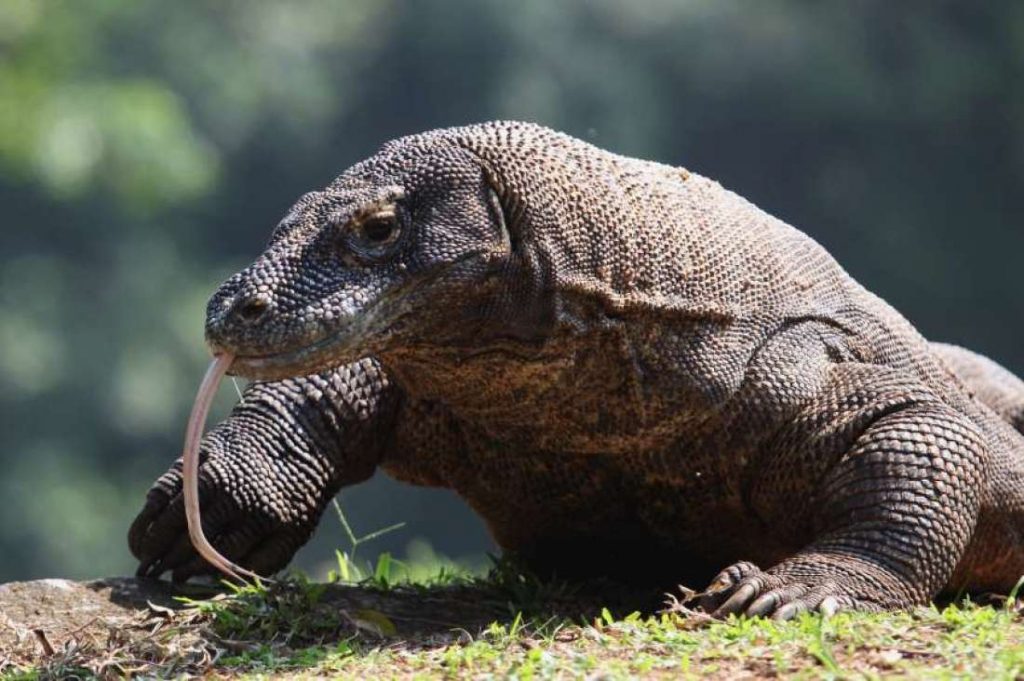Apart from being earth’s heaviest lizard, behavior like man-eating and grave-robbing are the Komodo dragon’s biggest claims to fame. But did you know that these guys are also surprisingly intelligent—even playful—creatures gifted at both long-distance swims and virgin births? Read on to learn more.
1. They’re Also Called Oras.
Western scientists didn’t find out about the giant reptiles until 1912, but long before they finally showed up on academia’s radar, Komodo Island natives had given them the name “ora,” which means “land crocodile.”
2. Komodos are Excellent Swimmers.
Traveling between Indonesian islands is often a necessity for hungry Komodo dragons; the animals are sometimes spotted paddling along miles off shore.
3. Around These Carnivores, No Carcass is Safe.

Snakes and many lizards have forked tongues to pick up microscopic, airborne taste particles. After being exposed to air, the tongue gets retracted and its prongs are inserted into the animal’s Jacobson’s organ (located on the roof of its mouth). This enables the reptile to identify whatever flavors it’s just picked up, which allows Komodo dragons to start tasting a scrumptious carrion dinner from more than two miles away.
4. George H.W. Bush Received a Live One as a Gift.

Halfway through his only term, Bush 41 was given an ora male, courtesy of Indonesia’s government, named Naga. While the idea of letting a giant varanid prowl around the Oval Office sounds pretty awesome, the president instead chose to hand him over to the Cincinnati Zoo. After fathering 32 youngsters, the illustrious critter passed away in 2007 at the respectable age of 24.
5. We Recently Learned That They’re Venomous.
Ten years ago, scientists believed that these scavengers has saliva laden with really deadly bacteria, and that bites containing the spit were potent enough to bring down a water buffalo. But that wasn’t actually the case: In 2009, biochemist Brian Fry tested this conventional wisdom by hunting for dangerous microorganisms inside several Komodo dragon mouths. He learned that, contrary to popular opinion, their chops have proportionally fewer bacteria than most meat-eating mammals do. Furthermore, Fry found no trace of any especially-hazardous ones. What he did find was venom glands. Situated in the lower jaw, these release a nasty cocktail that causes paralysis, extreme blood loss, inadequate clotting, tissue damage, and excruciating pain. Those poor buffaloes never stood a chance.
6. Komodos Can Consume 80 Percent of Their Body Weight in One Sitting.
Having freakishly-flexible jaws really helps these creatures gorge. As you can see in the clip above, Komodos can swallow smallish animals (like mid-sized piglets) whole.
7. During the Last 41 Years, They’ve Killed at Least Four People.

Mortal encounters were documented in 1974, 2000, 2007, and 2009. The most recent attack involved a man who fell from an apple tree and was mauled by two dragons while lying dazed on the ground. As a general rule, Komodo dragons prefer raiding graves to killing people, so natives frequently pile rocks over their loved ones’ tombs as a deterrent.
8. Females Can Reproduce Without Having Sex.

Future dragon mommies needn’t wait around for some handsome male. On multiple occasions, captive females have laid eggs that produced healthy babies despite failing to copulate first. In fact, one mother had never even shared an enclosure with a member of the opposite sex before. Here’s how it works: When no males are around, female Komodo dragons—like certain other lizards—may practice something called “parthenogenesis.” Basically, this means that, in lieu of sperm, certain egg cells can fertilize each other.
9. Smaller Ones Roll Around in Feces to Avoid Getting Cannibalized.

Adults are anything but picky eaters and won’t think twice about devouring their own offspring. Until they grow large enough to fend for themselves, young Komodos keep away from hungry grown-ups by taking to the trees, where they become nimble, branch-climbing predators. Still, this isn’t always enough. When close encounters are imminent, juveniles make themselves as unappetizing as possible by rolling in dung, which not even the most ravenous dragons can stomach.
10. Komodos Demonstrate Play Behavior.
Kraken, a resident of the National Zoological Park in Washington, D.C., is slowly changing the way scientists look at reptiles. Over the years, she has learned to come when whistled to and can even recognize her individual caretakers. But that’s not all: Kraken may even have a fun-loving side.
Park officials started getting curious when, for no apparent reason, she kept gingerly removing objects from employees’ pockets and tugging on their shoelaces. Intrigued, researchers gave Kraken everything from Frisbees to blankets to beverage cans. The huge lizard took a lively interest in all of them, leading some scientists to conclude that, if she were a mammal, we’d call her behavior “playful.”
According to psychologist Gordon Burghardt, in order to qualify as “play,” a given activity must be—among other things—voluntary, repeated, and conducted under “relatively benign” circumstances. Kraken’s researchers found that her conduct during the study met all of Burghardt’s criteria. “Kraken,” they wrote, had clearly demonstrated “play-like behavior with objects and even with humans (tug-of-war).” Moreover, she “could discriminate between prey and nonprey” while showing “varying responses” with different items (rubber rings, shoes, etc.).
If this team is on to something, Komodo dragons are a far cry from those lumbering dimwits you learned about in high school biology class. Instead, maybe we should start thinking of them as the inquisitive, vivacious lizards they now appear to be.
All images courtesy of iStock.






